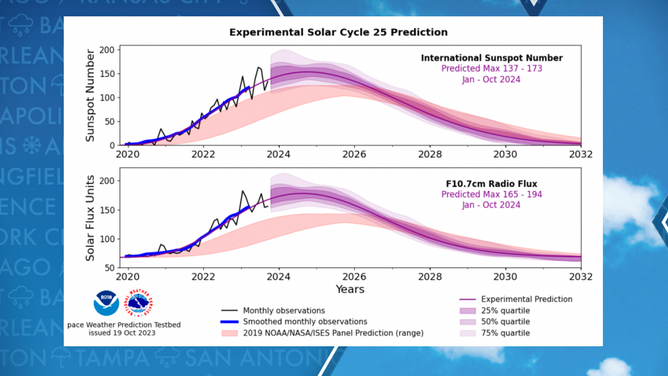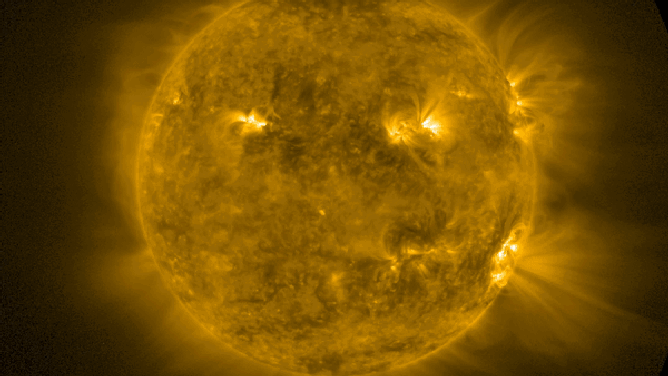NOAA predicts stronger peak of solar activity in 2024 than originally anticipated
Solar Cycle 25 began in 2019 and could last up until 2030. Even with the updated predictions of more sunspots, the strength of the cycle is still expected to be generally weaker than average. Solar Cycle 24 generally lasted from 2008 to 2019, with a peak in 2014.
Watch: Massive solar flare explodes on the Sun, leads to radio blackout on Earth
A massive solar flare exploded on the surface of the Sun last Friday and led to a
NOAA’s Space Weather Prediction Center has revised predictions surrounding the peak activity of Solar Cycle 25 and now believes the event could be more intense and peak sooner than expected.
The center said original predictions for a peak to occur in July 2025 may be off, and the globe should expect the height of activity to now occur during early to mid-2024.
A solar cycle is a sequence the sun’s magnetic field goes through every 11 years, where the field flips. Solar Cycle 24 generally lasted from 2008 to 2019, with a peak in 2014.
As the magnetic field changes, experts have long warned about fluctuations in the amount of solar activity and sunspots on the surface of our star.

NOAA’s Space Weather Prediction Center outlook for Solar Cycle 25
(FOX Weather)
SEE THE OBJECTS HUMANS LEFT BEHIND ON THE MOON
Sunspot activity is now expected to peak at between 137 and 173 sunspots, which is higher than initial forecasts.
An increase in activity has been tied to effects on Earth, with an increase in auroras and impacts on communications as well as electrical grids.
"We expect that our new experimental forecast will be much more accurate than the 2019 panel prediction and, unlike previous solar cycle predictions, it will be continuously updated on a monthly basis as new sunspot observations become available," Mark Miesch, a lead scientist at the SWPC, said in a statement. "It’s a pretty significant change."
Even with the updated predictions of more sunspots, the strength of the cycle is still expected to be generally weaker than average but more significant than what was experienced during the previous solar event.
NOAA said Solar Cycle 24 was the weakest cycle in modern history, with sunspots peaking at about 116 – below the average of 179.
"No two solar cycles are the same," SWPC officials said. "Solar magnetic variability regulates the frequency and severity of space weather events and hazards, which can interfere with the electrical grid, degrade GPS signals, increase orbital drag on satellites, and pose radiation hazards to airline crews and astronauts."
WHAT IS THE 11-YEAR SOLAR CYCLE?

Imagery showing solar activity from the sun in 2021.
(NASA)
The agency did not go into details on what triggered the significant change in its thinking but has long warned that many forecasts related to space events are experimental and are subject to significant errors.
Authors of a study published by the American Geophysical Union maintain that increased observations and data are needed to improve space outlooks.
A failure to anticipate the correct strength of a geomagnetic storm in 2022 was blamed for the loss of more than 3 dozen SpaceX satellites that burned up in Earth’s atmosphere.
